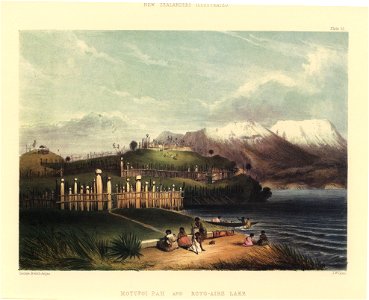Motupoi pah, with roto-aire lake. Tongariro in the distance. [image of page 77]
plate xxxii. Motupoi pah, with roto-aire lake. Tongariro in the distance. The pah of motupoi is erected upon a neck of land that juts out and rises like an island from the bosom of roto-aire lake: this pah is strongly fortified, and at the time of my visit, the native inhabitants were busily employed in repairing and completing the fortifications; the fact being (though it was kept a secret), that they were expecting a sudden attack from some of the waikato tribes, in retaliation for an old offence which had lately been brought into notice. Mungakahu, the chief of this pah, is a pikopo, or roman catholic; several of his people have also embraced popery, and at sunset vespers were said in front of the chief s house. The fortifications consist of three separate rows of palisading formed of stout posts, with smaller ones intervening, all lashed firmly together with flax or aha: the outer stockade is very strong, and a double fence runs along inside to render it still more secure; within the third enclosure upon the summit of the hill, are the dwelling houses of the inhabitants, and it is to this stronghold that the women and children retreat during an attack from some hostile tribe. On the summit of the hill to the left is a small enclosure or wahi tapu; a sacred place containing a patuka, in which are deposited the bones of a distinguished chief. In the foreground, near a bush of the phormium tenax, or new zealand flax, is a fallen post, carved at one end with the grotesque representation of a human figure, which has been used for supporting the fence-work of the pah; a group of natives are resting beside it, preparing to start across the lake with their potato baskets to the opposite village. The lower crater of tongariro forms a magnificent object in the distance, with the snow stretching down its precipitous sides. Date: 1847.
Loading...
